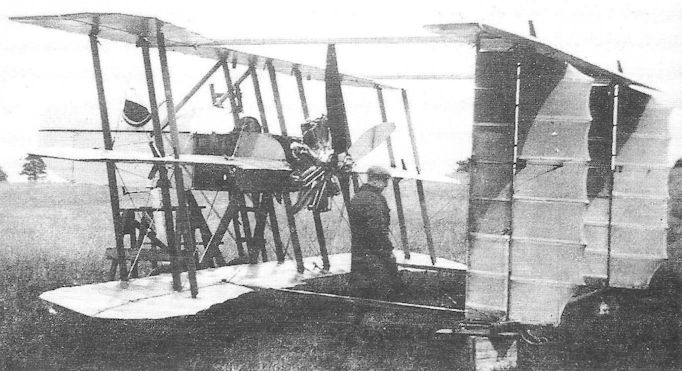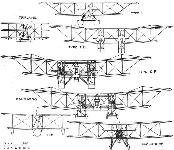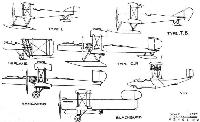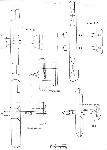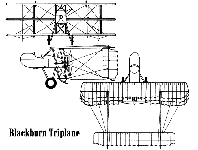A.Jackson Blackburn Aircraft since 1909 (Putnam)
Blackburn Triplane
While the batch of T.B. seaplanes was going through the Blackburn works, the firm was also engaged in the construction under contract of two examples of another anti-Zeppelin fighter, the A.D. Scout (later known as the Sparrow), designed by Harris Booth of the Air Department of the Admiralty. This aircraft was a heavily-staggered, single-bay biplane of extremely unorthodox appearance, built to meet an Admiralty requirement for a fighter built from commercially obtainable materials and which could be armed with the Davis two-pounder quick-fire recoilless gun. This lay in the bottom of a short, single-seat nacelle, the top longerons of which were bolted directly to the main spars of the upper wing. With the 100 hp Gnome Monosoupape rotary driving a 9-ft pusher airscrew behind his back, the pilot had a superlative view in nearly every direction.
The aircraft's extraordinary appearance stemmed from the fact that the abnormally large mainplane gap was below instead of above the nacelle, and because the twin fins and rudders, no less than 11 ft apart, were mounted on two pairs of parallel outriggers and supported a vast tailplane of 21-ft span. A suitably bizarre undercarriage reversed the usual pattern, the three points of contact with terra firma being widely spaced skids under the fins and a pair of small wheels mounted close together centrally under the lower mainplane. In this respect it was similar to the Armstrong Whitworth F.K.12 triplane and the projected Bristol F.3A escort and anti-Zeppelin fighters, for it seems that Harris Booth believed in the 'pogo stick' type of landing gear as a means of simplifying cross-wind landings at night.
Four prototype aircraft only were ordered, 1452 and 1453 from Hewlett and Blondeau Ltd of Leagrave, Beds., and two others, 1536 and 1537, from Blackburns. They were all delivered to RNAS Chingford, but being considerably above their estimated all-up weight and difficult to handle in the air, were scrapped.
In 1916 Harris Booth left the Air Department of the Admiralty to join the Blackburn Aeroplane and Motor Co Ltd for whom he immediately designed what can only be regarded as a modified version of his A.D. Scout. To impart the high rate of roll needed by a slow machine taking evasive action round a target Zeppelin, the span was reduced from 33 ft 5 in to 24 ft but the lost wing area was regained by adopting a triplane configuration. It was then fitted with six inversely-tapered ailerons, those on the centre mainplane being cable-controlled from the cockpit and operating those above and below through link struts. The aircraft inherited the A.D. Scout's ugly nacelle and heavy stagger as well as the four parallel tail booms and outsize tailplane of no less than 18 ft 10 in span. The rudders were more enormous than ever so that altogether the Triplane was one of the most extraordinary looking aircraft ever built.
The two-wheel arrangement of the A.D. Scout was replaced by a bungee-sprung, V-type, cross-axle undercarriage of moderate track, but the bottom wing was so close to the ground that substantial wing tip skids were also necessary. In other respects the Triplane was structurally similar to its predecessor and had a wire-braced, fabric-covered wooden airframe which used metal fittings of commercial mild steel. Wing, tailplane and rudder trailing edges were formed from stout wire which gave under the tautening effect of the dope to form a scalloped shape between the ribs.
Only one prototype Triplane, N502, was built, and although contemporary photographs clearly show the gun port in the nose of the nacelle, it is doubtful if the Davis gun was ever fitted. The aircraft was erected in the Soldiers' Field at Roundhay Park, Leeds, where initial engine runs were made before despatch to Eastchurch at the end of 1916. The aircraft flew first with a 110 hp Clerget driving an 8ft-diameter four-bladed airscrew and later with a 100 hp Gnome and two-bladed airscrew. Admiralty acceptance took place at Eastchurch on 20 February 1917, but the Blackburn Triplane proved no more successful than the A.D. Scout and was struck off charge as unsatisfactory one month later on 19 March. Its end, like that of many another undeveloped pusher aircraft, was no doubt hastened by the invention of interruptor gear which enabled machine-guns to fire through the airscrew disc on tractor machines.
SPECIFICATION AND DATA
Manufacturers: The Blackburn Aeroplane and Motor Co Ltd, Olympia Works, Roundhay Road, Leeds, Yorks.
Power Plants:
(A.D. Scout) One 100 hp Gnome Monosoupape
(Triplane)
One 110 hp Clerget
One 100 hp Gnome Monosoupape
Dimensions:
(A.D. Scout)
Span 33 ft 5 in Length 22 ft 9 in
Height 10 ft 3 in
(Triplane)
Span 24 ft 0 in Length 21 ft 5 ft in
Height 8 ft 6 in Wing area 221 sq ft
Weights: (Triplane, Gnome) Tare weight 1,011 lb All-up weight 1,500 lb
Performance: No confirmed details
Production:
(A.D. Scout) Four aircraft only, 1452 and 1453 by Hewlett and Blondeau Ltd; 1536 and 1537 by Blackburn, to Contract 38552 15
(Triplane) One aircraft only, N502, to Contract CP. 120730 16
P.Lewis The British Fighter since 1912 (Putnam)
Contemporary with the A.D. Scout was the Blackburn Triplane, N502, which was designed late in 1915 and which exhibited several features in common with the A.D. machine. In particular, the Triplane possessed the same exaggerated gap between the tail booms which carried also the similar style of broad-span horizontal tail surfaces. The nacelle was mounted ahead of the centre wings of the single-bay cellules, and an undercarriage of normal height and track was provided. Additional ground stability was ensured by tip skids under the interplane struts.
The single forwards-firing gun was installed in the lower half of the nose of the nacelle, at the rear of which was fitted the 100 h.p. Monosoupape Gnome; the 110 h.p. Clerget was an alternative engine tested in the Triplane. Compared with the size of the fins, the rudders were large, and a fair measure of lateral control area was provided by fitting strut-connected ailerons on each of the six wingtips.
F.Mason The British Fighter since 1912 (Putnam)
Blackburn Triplane
At a time when it must have seemed that British aircraft designers were prepared to go to any lengths to create the oddest conceivable fighters in their search for a solution of the forward-firing gun requirement, even the Blackburn Triplane appears anachronistic, to say the least.
It will be recalled that the eccentric Harris Booth, while at the Admiralty’s Air Department, had designed a peculiar pusher biplane, known as the A.D. Sparrow scout, and that two such aircraft were built by the Blackburn company of Leeds. In 1916 Booth left the Air Department and immediately joined Blackburn, where he set about the design of a pusher triplane which one can only conjecture as being loosely based on his original Sparrow concept with which he seems to have been obsessed.
Retaining the Sparrow’s parallel tail booms, its huge tailplane and tailskids at the base of the rudders, the nacelle was arguably of improved shape, through which the spars of the centre wing passed. A wider-track undercarriage was provided and, initially, a 110hp Clerget rotary was selected. All flying surface trailing edges were formed with wire - which imposed an archaic appearance of scalloped edges when the fabric tautened under the effects of dope. Booth even proposed retaining the two-pounder Davis recoilless gun although it is difficult to reconcile this weapon with the aircraft’s role as a scout.
The aircraft was completed towards the end of 1916 when it was despatched to Eastchurch, having undergone an engine change to the 1000hp Gnome monosoupape. On 20 February 1917 the Triplane was accepted by the Admiralty as N502, but one month later it was struck off charge as serving no useful purpose. It had been claimed that the aircraft possessed a maximum speed of 115 mph with the monosoupape engine, but this must be discounted as most improbable.
Type: Single pusher engine, single-seat, single-bay triplane scout.
Manufacturer: Blackburn Aeroplane & Motor Co Ltd, Leeds.
Powerplant: One 110hp Clerget engine driving four-blade propeller; later one 100hp Gnome monosoupape with two-blade propeller.
Dimensions: Span, 24ft 0in; length, 21ft 5 5/16 in; height, 8ft 6in; wing area, 221 sq ft.
Weights: (100hp Gnome). Tare, 1,011lb; all-up, 1,500lb.
Performance: (100hp Gnome). Max speed, probably approx 95 mph; endurance, 3 hr.
Armament: Intended as one 2-pdr Davis recoilless gun in nose of nacelle.
Prototype: One, N502.
W.Green, G.Swanborough The Complete Book of Fighters
BLACKBURN TRIPLANE UK
Designed by Harris Booth, who was also responsible for the A.D. Scout, the Blackburn single-seat fighter triplane was intended to carry a single Davis two-pounder quick-fire recoilless gun firing from the nose of the nacelle and was conceived for the anti-Zeppelin role. Possessing a fabric-covered airframe, the triplane was initially flown early in 1917 with a 100 hp Clerget 9Z nine-cylinder rotary engine driving a four-bladed propeller. The Clerget was soon replaced by a Gnome Monosoupape nine-cylinder rotary of 100 hp driving a two-blade propeller and the triplane was accepted by the Admiralty on 20 February 1917, but was struck off charge as unsatisfactory four weeks later, on 19 March.
Approx max speed, 90 mph (145 km/h).
Endurance, 3 hrs.
Empty weight, 1,011 lb (458,5 kg).
Loaded weight, 1,500 lb (680 kg).
Span, 24 ft 0 in (7,31m).
Length, 21ft 5 1/4 in (6,53 m).
Height, 8 ft 6 in (2,59 m).
Wing area, 221 sq ft (20,53 m2).
J.Bruce British Aeroplanes 1914-1918 (Putnam)
Blackburn Triplane
WORK on the design of the Blackburn Triplane began at the end of 1915. It was a single-seat fighter which was intended to achieve the same object as the contemporary D.H.a; namely, to provide a fighting aircraft with armament which could be fired straight ahead.
The Blackburn Triplane obviously owed a good deal to the A.D. Sparrow, for which the Blackburn company had been contractors, and it is probable that Harris Booth had a hand in the design of the triplane. There was the same enormous gap between upper and lower tail-booms; a long-span tailplane was fitted; there were two large, widely-spaced fins and rudders; and in appearance the nacelle was as uncouth as that of the Sparrow. On the triplane, ailerons were fitted to all wings; only the central ailerons were connected directly to the pilot’s control column, and the top and bottom surfaces were actuated by connecting struts. The tail-booms were parallel in both plan and side elevation, and the entire tail assembly appeared to be of doubtful rigidity. The machine was flown with both the 100 h.p. Gnome Monosoupape and the 110 h.p. Clerget engines: in the latter case a four-bladed airscrew was used.
The only available performance figures credit the Triplane with a maximum speed of 115 m.p.h. with the Monosoupape engine, but this claim must be regarded as somewhat optimistic; for the D.H.2 could reach only 93 m.p.h. with the same engine.
It has been said that two Blackburn Triplanes were built, one of which was tested at York and the second sent to Eastchurch. However, it seems unlikely that two machines existed; it is more probable that a confusion with the A.D. Sparrow arose.
SPECIFICATION
Manufacturers: The Blackburn Aeroplane & Motor Co., Ltd., Olympia, Leeds.
Power: 100 h.p. Gnome Monosoupape; 110 h.p. Clerget.
Dimensions: Span: 24 ft. Length: 21 ft 5 5/16 in. Chord: 3 ft 5 in. Gap: 3 ft 6 in. Stagger: 9 in. Dihedral: nil. Incidence: 2°. Span of tail: 18 ft. Wheel track: 5 ft. Airscrew diameter: 8 ft.
Areas: Wings: top 79-108 sq ft, middle 67-116 sq ft, bottom 74-806 sq ft, total 221-03 sq ft. Ailerons: each 6-53 sq ft, total 39-2 sq ft. Tailplane: 29-7 sq ft. Elevators: 25-1 sq ft. Fins: 15-2 sq ft. Rudders: 23-9 sq ft.
Weights: Empty: 1,011 lb. Military load: 50 lb. Pilot: 180 lb. Fuel and oil: 259 lb. Weight loaded: 1,500 lb.
Performance (with Monosoupape engine): Maximum speed: 115 m.p.h. Endurance: 3 hours.
Armament: One free-mounted forward-firing Lewis machine-gun in front of pilot.
Serial Number: N.502, built under Contract No. C.P. 120730/16.
H.King Armament of British Aircraft (Putnam)
Triplane. The layout of this single-seat 'scout' of 1915-16 was much along the lines of the A.D. Scout, and concerning the supposed intended armament of a Davis recoilless gun the same remarks apply. A nacelle-mounted Lewis-gun installation was certainly schemed, this being intended (according to a Blackburn document) to give 'an exceptional arc of fire'. A makers' drawing, dated June 1916, shows this triplane armed with a single land-service Lewis gun, apparently having freedom of movement only in elevation, mounted on the nacelle with the 47-round ammunition drum and entire breech casing housed in a 'hump' fairing immediately ahead of the cockpit. 'Military load' was stated by Blackburn to be a mere 50 lb.
Журнал Flight
Flight, December 11, 1919.
"MILESTONES"
THE BLACKBURN MACHINES.
The Triplane Scout. (December, 1915)
In appearance one of the most extraordinary aeroplanes ever built was a little Blackburn triplane produced in 1915. At that time the synchronized machine gun had not been generally adopted, and consequently there was a demand for machines in which the pilot was free to fire in a forward direction. The D.H.2, for instance, was a reply to this demand, and the Blackburn triplane was designed with a similar purpose in view. The machine was provided with a machine gun firing forward through the nose of the nacelle, and consequently gave the pilot a very free field. In a rearward direction also the view was quite good, the middle plane being on a level only slightly lower than that of the pilot's eyes.
The engine fitted was a rotary 100 h.p. Gnome or 110 h.p. Clerget, both being tried. Considering that the machine was a pusher, which type is not usually as fast as the tractor type of machine of the same power, the performance of the Blackburn was quite good, the maximum speed being 115 m.p.h. With the invention of the synchronising gear for machine guns the raison d'etre for the pusher type disappeared and the construction was discontinued.

